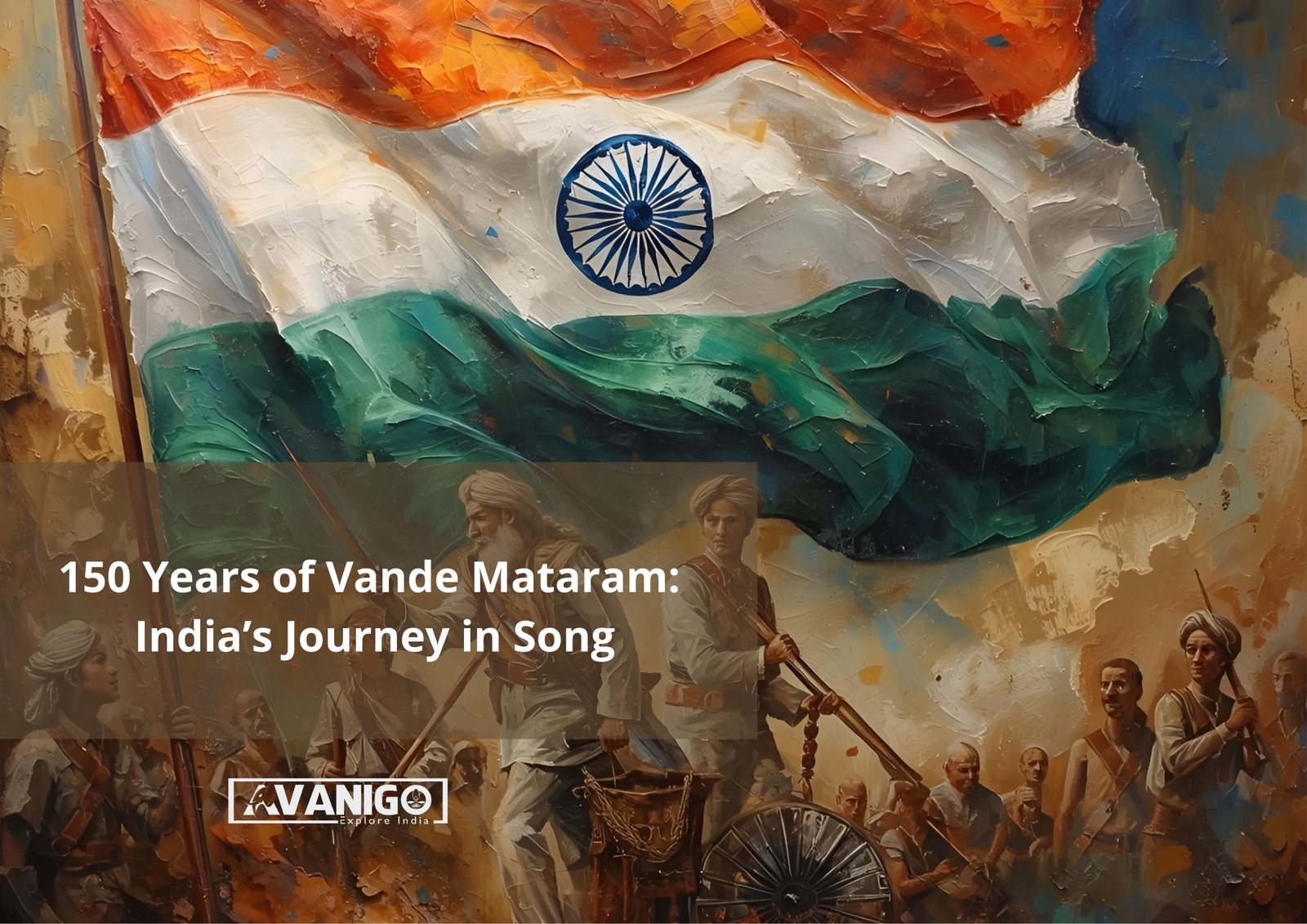
In the year 2025, India marks 150 years of the song Vande Mataram. This song is not just a piece of music—it’s a symbol of the country’s journey toward Indian Independence, of shared hopes, struggles, and identity. While Jana Gana Mana is known as the National Anthem of India, VandeMataram holds the place of the National Song of India, and deserves its story to be told in full.
Quick Navigation
What is Vande Mataram?
- The title Vande Mataram means “I bow to thee, Mother.”
- It was composed by Bankim Chandra Chattopadhyay in the 1870s, in a Sanskritised Bengali form. Sanskrit and Bengali are some of the classical languages of India.
- The poem first appeared in print on 7 November 1875 in the journal Bangadarshan.
- It was later included in Chattopadhyay’s novel Anandamath (1882) which provided a story context of rebellion and upheaval.
In short: what started as a poem became a powerful symbol of the motherland.
The Journey from Poem to Political Symbol
Early Literary Origins
Vande Mataram began in a calm setting—a literary one—not necessarily with an immediate political mission. But the idea of “Mother India” and the poetic imagery struck a chord.
Rise During the Freedom Movement
As the struggle for Indian Independence grew stronger, so did the song’s significance.
- In 1896, the famous poet and thinker Rabindranath Tagore first sang it at the session of the Indian National Congress in Kolkata.
- By 1905, during the Partition of Bengal protests, it became a rallying cry: thousands of people chanted “VandeMataram!” during processions.
- The British colonial authorities recognised its power and in some cases banned it or restricted its use.
Adoption as National Symbol
When India became a republic in 1950, Vande Mataram was formally adopted as the National Song on 24 January 1950.
At the same time, Jana Gana Mana was adopted as the National Anthem. The aim was that both songs be honoured but with different roles:
- Jana Gana Mana for formal state occasions
- Vande Mataram as a cultural-historic symbol of the nation’s journey
Vandemataram Significance & Meaning
Why does Vande Mataram still matter today?
- Emotional connection: The idea of the “Motherland” as a nurturing, protective, yet proud force is both poetic and powerful.
- National unity: At key moments in the freedom movement, singing the song brought together people across regions and languages for a common cause.
- Cultural legacy: It is part of how India remembers its struggle, celebrates its identity, and educates younger generations about the sacrifices made.
Vandemataram The 150-Year Celebration: 2025–26
In 2025 India began a year-long commemoration of the 150th anniversary of Vande Mataram. Significant features:
- A programme of events launched on 7 November 2025, marking the publication of the poem in 1875.
- Cultural programmes, school events, mass singing of the song at railways, public places, and institutions. For example, the East Coast Railway’s Waltair Division held mass singing across stations.
- Governments issuing commemorative stamps, coins and conducting exhibitions, seminars and competitions with young people.
Controversies & Debates
Even heroic symbols have complex histories. Vande Mataram carries some controversies, which help us understand how national songs must be inclusive.
- Some lines of the poem invoke Hindu goddesses and describe the “Motherland” in religious-symbolic terms. This has been seen by some as conflicting with secular or religious minority perspectives.
- In the 1930s, the Muslim League formally expressed objection to part of the song, calling it “idolatrous” and “against” certain religious beliefs.
- Most recently, in November 2025 the state of Uttar Pradesh announced Vande Mataram would be mandatory in schools; this sparked debate about freedom of expression and religious freedom.
These debates do not diminish the value of the song; rather they reflect that symbols must remain relevant and sensitive to changing societies.
How Schools & Youth Can Connect With the Song
For students and young people, Vande Mataram offers several lessons:
- Think about why we sing. It’s not only a tradition, but tied to history, identity and freedom.
- Reflect on what it means to serve or respect the “motherland” in today’s world — is it through education, service, community work?
- Use the 150-year milestone to learn:
- The story of the freedom struggle
- The difference between National Anthem and National Song
- The importance of inclusive national symbols
- Activities schools might undertake:
- Mass singing of Vande Mataram combined with a discussion of its meaning
- Art and essay competitions on “What Motherland means to me” on national festivals like Gandhi Jayanthi, Republic Day and Independence Day
- Exhibitions or projects tracing the song’s journey from 1875 to 2025
Comparison of Vande Mataram and Jana Gana Mana
| Song | Role | Key Features |
| Vande Mataram | National Song of India | Originated as a poem, became a rallying cry for independence; evokes the motherland as a nurturing figure. |
| Jana Gana Mana | National Anthem of India | Written by Rabindranath Tagore; emphasises the unity and diversity of our Incredible India; used in formal state functions. |
Both songs are important—it is not that one replaces the other. Instead they complement each other: one connects to the emotional heritage of the independence movement, the other to official state-protocol and national unity.
Legacy for Future Generations
As India looks ahead, the legacy of Vande Mataram points to how a country can honour history while being inclusive and forward-looking.
- Remembering: It helps keep alive the memory of those who worked for freedom.
- Teaching: It becomes a tool in education to connect children with the past.
- Uniting: It offers a shared cultural moment in a diverse country.
- Reflecting: It encourages the nation to ask: how do we define “motherland”? How do we ensure everyone is included in that vision?
In its 150th year, Vande Mataram invites all Indians — young and old — to sing, reflect and commit to the values of service, respect and unity.
Conclusion
From the pages of a late-19th-century Bengali novel to the voices of thousands singing in railway stations, schools and public squares, Vande Mataram has travelled a long journey. It is a song that witnessed India’s struggle for freedom, became part of its national identity, and now celebrates 150 years. As we honour it, we also honour the idea that a nation’s symbols must be alive, inclusive and meaningful.
Vande Mataram!
Frequently Asked Questions (FAQs) about Vande Mataram
- Who wrote Vande Mataram?
Vande Mataram was written by Bankim Chandra Chatterjee (also spelled Bankim Chandra Chattopadhyay), one of India’s most respected writers and poets. He wrote it in the 1870s, and it was first published on 7 November 1875 in the magazine Bangadarshan.
- What does Vande Mataram mean?
The phrase Vande Mataram means “I bow to thee, Mother.” In the song, “Mother” refers to Mother India, the country itself. It is a way of showing respect, love, and gratitude toward the nation.
- When did Vande Mataram become India’s National Song?
Vande Mataram was officially adopted as the National Song of India on 24 January 1950, just before the Constitution of India came into effect. On the same day, Jana Gana Mana was adopted as the National Anthem.
- What is the difference between the National Anthem and the National Song?
The National Anthem, Jana Gana Mana, is sung at official state events and functions.
The National Song, Vande Mataram, is sung during cultural programmes, school ceremonies, and patriotic events. Both songs represent India’s unity and freedom.
- Why is Vande Mataram important in India’s freedom movement?
During the Indian Independence movement, Vande Mataram was used as a slogan of courage and unity. Freedom fighters sang it during rallies, protests, and marches. It inspired people to come together and work for a free India.
- Why do people sometimes debate about Vande Mataram?
Some people raised concerns about the later verses of the poem, which mention Hindu goddesses. To make it inclusive, only the first two stanzas—which describe the beauty of the motherland—are officially sung as the National Song today.
- When was VandeMataram first sung publicly?
It was first sung at the Indian National Congress session in 1896, by Rabindranath Tagore, years before India’s independence.
- How is India celebrating 150 Years of Vande Mataram?
In 2025–2026, India is holding a year-long celebration with special programmes in schools, cultural institutions, and railway stations. The government has also issued commemorative stamps and coins to mark the 150-year milestone.
- How can students take part in the celebration?
Students can participate by singing Vande Mataram in school assemblies, learning about its history, making posters, writing essays, or performing short plays that show its role in the freedom struggle.
- Who was Bankim Chandra Chatterjee?
Bankim Chandra Chatterjee (1838–1894) was a famous Indian writer, poet, and civil servant from Bengal. He is known for his novels like Anandamath, Durgeshnandini, and for writing VandeMataram, which became the National Song of India.
Swetha is a Content Specialist, LinkedIn Branding and B2B Marketing Consultant. When she is not in the world of B2B, she researches the roots and beauty of Indian Culture and Traditions. She is the author of the book: 365 Days 365 Posts – The Guide to LinkedIn Personal Branding, available exclusively on Amazon. Connect with her on LinkedIn.



